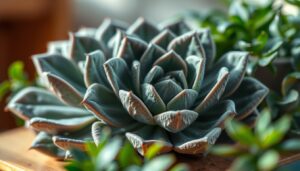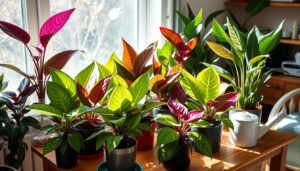
Introduction
Spider plants, known scientifically as Chlorophytum comosum, are beloved for their resilience, air-purifying qualities, and gracefully arching leaves. Originating from Southern Africa, these plants have gained immense popularity worldwide due to their ease of care and striking appearance. While the classic green and white variegated spider plant is the most well-known, the world of spider plants encompasses a variety of cultivars, each with its own unique features and charm.
In this article, we delve into the diverse array of spider plant varieties, exploring their distinct characteristics, growth habits, and care requirements. Whether you’re a seasoned plant enthusiast or a novice green thumb, join us on this journey as we uncover the beauty and diversity within the fascinating world of spider plants.
Spider Plant Varieties: A Closer Look
As we delve deeper into the realm of spider plants, it becomes evident that their diversity extends far beyond the familiar green and white variegated leaves. From subtle variations in leaf coloration to unique growth habits, each variety offers its own distinct appeal. Let’s explore some of the most notable spider plant varieties:
- Chlorophytum comosum ‘Vittatum’ (Variegatum): The classic spider plant variety, characterized by its long, arching leaves adorned with creamy white stripes. This cultivar is renowned for its air-purifying properties and adaptability to various light conditions, making it a popular choice for indoor spaces.
- Chlorophytum comosum ‘Bonnie:‘ With shorter, more compact leaves than the ‘Vittatum’ variety, ‘Bonnie’ is prized for its bushy growth habit and prolific production of offsets, or “spiderettes.” These miniature plants dangle gracefully from the parent plant, adding visual interest to hanging baskets and shelves.
- Chlorophytum comosum ‘Reverse Variegatum’: A striking variation of the traditional spider plant, ‘Reverse Variegatum’ boasts dark green leaves with contrasting white margins. This unique coloration adds a touch of elegance to any indoor setting and makes it a standout choice for plant enthusiasts seeking something out of the ordinary.
- Chlorophytum comosum ‘Mandarin:’ Named for its vibrant orange-colored foliage, ‘Mandarin’ is a captivating cultivar that adds a pop of color to any space. While its leaves retain the characteristic spider plant shape, their eye-catching hue sets ‘Mandarin’ apart as a bold and distinctive choice for plant enthusiasts.
- Chlorophytum comosum ‘Zebra Grass’: True to its name, ‘Zebra Grass’ features striking striped foliage reminiscent of its namesake. The alternating bands of dark and light green create a visually dynamic effect, making this variety a standout addition to any indoor garden or landscape.
- Chlorophytum comosum ‘Curly Bonnie’: A playful twist on the traditional spider plant, ‘Curly Bonnie’ features leaves that curl and twist as they grow, adding a whimsical touch to its appearance. This quirky variety is sure to captivate attention and spark conversation among plant enthusiasts.
- Chlorophytum comosum ‘Green’: While not as flashy as some of its variegated counterparts, the all-green spider plant variety has its own understated beauty. With solid green foliage and a vigorous growth habit, ‘Green’ is a reliable choice for those seeking a low-maintenance plant with timeless appeal.
Table:
Variety | Description |
‘Vittatum’ (Variegatum) | Classic green and white variegated leaves; adaptable and air-purifying. |
‘Bonnie’ | Compact growth habit with prolific production of offsets; ideal for hanging baskets. |
‘Reverse Variegatum’ | Dark green leaves with white margins; adds elegance to indoor spaces. |
‘Mandarin’ | Vibrant orange-colored foliage; makes a bold statement in any setting. |
‘Zebra Grass’ | Striking striped foliage; visually dynamic and eye-catching. |
‘Curly Bonnie’ | Leaves curl and twist as they grow; adds a whimsical touch to indoor gardens. |
‘Green’ | Solid green foliage with a vigorous growth habit; low-maintenance and timeless. |
Caring for Spider Plants: Tips and Guidelines
Now that we’ve explored the diverse array of spider plant varieties, it’s essential to understand how to care for these resilient and versatile plants. Whether you’re a seasoned plant enthusiast or a novice gardener, following these tips and guidelines will help ensure your spider plants thrive:
- Light Requirements: Spider plants are adaptable and can tolerate a wide range of light conditions, but they prefer bright, indirect sunlight. Avoid placing them in direct sunlight, as this can scorch their delicate leaves. If grown indoors, place your spider plant near a window where it can receive plenty of natural light without being exposed to direct sun rays.
- Watering: As with most houseplants, proper watering is crucial for the health of spider plants. Allow the soil to dry out slightly between waterings, but avoid letting it become completely dry. Overwatering can lead to root rot, while underwatering can cause the leaves to wilt and turn brown. Aim to keep the soil evenly moist, but not waterlogged, and adjust your watering frequency based on environmental conditions and the plant’s needs.
- Soil and Potting: Spider plants prefer well-draining potting mix with plenty of organic matter. A mix formulated for indoor houseplants or a combination of peat moss, perlite, and compost works well. Repot your spider plant into a slightly larger container every year or two to provide ample room for root growth. Ensure the pot has drainage holes to prevent water from accumulating at the bottom, which can lead to root rot.
- Temperature and Humidity: Spider plants thrive in moderate temperatures ranging from 65°F to 75°F (18°C to 24°C). Avoid exposing them to extreme temperatures or drafts, as this can stress the plant. While spider plants can tolerate average indoor humidity levels, they appreciate slightly higher humidity, especially during the dry winter months. Consider placing a humidifier nearby or misting the leaves occasionally to increase humidity levels.
- Fertilizing: Feed your spider plant with a balanced, water-soluble fertilizer diluted to half strength every two to four weeks during the growing season (spring and summer). Reduce fertilization frequency to once a month or less during the fall and winter months when growth slows down. Over-fertilizing can lead to salt buildup in the soil, so it’s essential to follow the recommended dosage and avoid applying fertilizer to dry soil.
Table:
Care Aspect | Guidelines |
Light Requirements | Prefer bright, indirect sunlight; avoid direct sunlight. |
Watering | Allow soil to dry slightly between waterings; avoid overwatering. |
Soil and Potting | Use well-draining potting mix; repot every 1-2 years; ensure drainage holes in pots. |
Temperature | Thrive in moderate temperatures (65°F to 75°F); avoid extreme temperatures and drafts. |
Humidity | Tolerate average indoor humidity; appreciate higher humidity levels, especially in dry conditions. |
Fertilizing | Feed with balanced, diluted fertilizer every 2-4 weeks during the growing season; reduce in fall/winter. |
Common Spider Plant Pests and Diseases: Identification and Control
While spider plants are generally resilient and low-maintenance, they can still fall victim to various pests and diseases if not properly cared for. Being able to identify and promptly address these issues is crucial for maintaining the health and vitality of your plants. Here are some common pests and diseases that may affect spider plants, along with tips for prevention and control:
- Spider Mites: These tiny pests, barely visible to the naked eye, are a common problem for spider plants, especially when grown indoors. Spider mites feed on the sap of plants, causing stippling, discoloration, and webbing on the leaves. To control spider mites, regularly inspect your plants for signs of infestation, particularly on the undersides of leaves. Prune and dispose of heavily infested foliage, and treat the plant with insecticidal soap or neem oil according to the manufacturer’s instructions.
- Mealybugs: Mealybugs are another common pest that can plague spider plants, especially in warm, humid conditions. These soft-bodied insects feed on plant sap and secrete a waxy substance that can coat leaves and stems. To combat mealybug infestations, remove affected plant parts and dab the pests with a cotton swab dipped in rubbing alcohol. You can also treat the plant with insecticidal soap or neem oil to eliminate remaining bugs.
- Fungal Diseases: Spider plants are susceptible to fungal diseases such as root rot and leaf spot, especially if overwatered or grown in poorly draining soil. Root rot occurs when the roots become waterlogged, leading to decay and wilting of the plant. To prevent root rot, ensure proper drainage in pots and avoid overwatering. Leaf spot, characterized by dark lesions on leaves, can be controlled by improving air circulation around plants and avoiding overhead watering.
- Leaf Tip Browning: Browning of leaf tips is a common issue with spider plants and is often caused by factors such as dry air, underwatering, or excess fertilizer salts in the soil. To prevent leaf tip browning, maintain moderate humidity levels around the plant, water consistently but avoid overwatering, and flush the soil periodically to remove excess salts.
Table:
Pest/Disease | Symptoms | Prevention and Control |
Spider Mites | Stippling, webbing on leaves | Inspect regularly, prune heavily infested parts, treat with insecticidal soap or neem oil. |
Mealybugs | Waxy coating on leaves, stunted growth | Remove affected parts, dab with alcohol, treat with insecticidal soap or neem oil. |
Fungal Diseases | Root rot, leaf spot | Ensure proper drainage, improve air circulation, avoid overwatering. |
Leaf Tip Browning | Browning of leaf tips | Maintain moderate humidity, water consistently, flush soil periodically. |
Propagation Techniques for Spider Plants: A Step-by-Step Guide
One of the joys of growing spider plants is the ease with which they can be propagated, allowing you to expand your collection or share plants with friends and family. Whether you’re a novice gardener or an experienced plant enthusiast, mastering propagation techniques for spider plants is a rewarding endeavor. Here’s a step-by-step guide to propagating spider plants using various methods:
- Propagation by Division: Division is perhaps the simplest and most common method of propagating spider plants. Follow these steps to divide a mature spider plant:
- Select a healthy, mature spider plant with multiple offsets (spiderettes) growing from the parent plant.
- Carefully remove the plant from its pot and gently separate the offsets from the parent plant using a clean, sharp knife or scissors.
- Each offset should have its own set of roots attached. If not, you can encourage root growth by placing the offset in water or potting mix until roots develop.
- Plant each offset in its own pot filled with well-draining potting mix and water thoroughly. Place the newly potted plants in a location with bright, indirect light and maintain consistent moisture until they become established.
- Propagation by Spiderettes: Spiderettes are miniature versions of the parent plant that grow from long, wiry stems. Follow these steps to propagate spider plants using spiderettes:
- Wait until the spiderettes have developed roots of their own, typically when they are 2-3 inches (5-8 cm) long.
- Carefully snip the spiderettes from the parent plant using clean scissors or pruning shears, ensuring each spiderette has a few inches of stem attached.
- Plant the spiderettes in small pots filled with well-draining potting mix and water thoroughly. Provide bright, indirect light and maintain consistent moisture until the new plants establish roots and begin to grow.
- Propagation by Plantlets: Spider plants also produce plantlets, or miniature versions of the parent plant, along the length of their arching stems. Follow these steps to propagate spider plants using plantlets:
- Wait until the plantlets have developed roots of their own, typically when they are a few inches long.
- Gently twist or cut the plantlets from the parent plant, ensuring each plantlet has a few inches of stem attached.
- Plant the plantlets in small pots filled with well-draining potting mix and water thoroughly. Provide bright, indirect light and maintain consistent moisture until the new plants establish roots and begin to grow.
Table:
Propagation Method | Description |
Division | Separating mature plant into smaller sections, each with roots attached, and planting them individually in pots. |
Spiderettes | Snipping miniature plants, or spiderettes, from the parent plant and planting them in pots once they have developed roots. |
Plantlets | Harvesting miniature plants, or plantlets, that grow along the arching stems of the parent plant and planting them in pots once they have developed roots. |
Conclusion: Embracing the Diversity and Resilience of Spider Plants
In conclusion, spider plants stand as testament to nature’s ingenuity, offering a myriad of varieties, each with its own unique charm and adaptability. From the classic variegated leaves to the vibrant hues of ‘Mandarin’ and the whimsical curls of ‘Curly Bonnie,’ these plants captivate our senses and enrich our living spaces with their beauty.
As we’ve explored the world of spider plants, we’ve uncovered not only their diversity but also their resilience in the face of adversity. Despite their susceptibility to pests and diseases, spider plants demonstrate an innate ability to thrive when provided with proper care and attention. By understanding their needs and addressing potential challenges proactively, we can ensure their continued health and vitality for years to come.
Moreover, spider plants offer us more than just visual appeal; they contribute to our well-being by purifying the air, enhancing indoor environments, and providing a connection to nature in our increasingly urbanized lives. Their ease of propagation further amplifies their allure, inviting us to share the joy of gardening with friends, family, and fellow enthusiasts.
In embracing the diversity and resilience of spider plants, we not only cultivate thriving indoor gardens but also cultivate a deeper appreciation for the natural world and its wonders. So let us continue to nurture these remarkable plants, celebrating their beauty and resilience as we journey together in harmony with nature.





Pingback: The Ultimate Beginner's Guide to the Most Wanted Indoor Plant for 2025 - Trusted House Plant Guide